Efficacy and Safety of Intravenous Magnesium Sulfate in Spinal Surgery: A Systematic Review and Meta-Analysis
Abstract
:1. Introduction
2. Materials and Methods
2.1. Eligibility Criteria
2.2. Information Sources and Search Methods for Identification of Studies
2.3. Data Extraction and Data Items
2.4. Assessment of Risk of Bias in Included Studies
2.5. Assessment of Results
2.6. Risk of Bias across the Studies
2.7. Additional Analyses
3. Results
3.1. Study Selection
3.2. Study Characteristics
3.3. Pain
3.4. Drug Consumption
3.5. Hemodynamics
3.6. Extubation Time, Response to Verbal Commands and Orientation Time
3.7. Adverse Events
3.8. Publication Bias
3.9. GRADE
4. Discussion
Limitations
5. Conclusions
Supplementary Materials
Author Contributions
Funding
Institutional Review Board Statement
Informed Consent Statement
Data Availability Statement
Conflicts of Interest
References
- Shetty, G.M.; Jain, S.; Thakur, H.; Khanna, K. Prevalence of low back pain in India: A systematic review and meta-analysis. Work 2022, 73, 429–452. [Google Scholar] [CrossRef] [PubMed]
- Ketenci, A.; Zure, M. Pharmacological and non-pharmacological treatment approaches to chronic lumbar back pain. Turk. J. Phys. Med. Rehabil. 2021, 67, 1–10. [Google Scholar] [CrossRef] [PubMed]
- Helm Ii, S.; Harmon, P.C.; Noe, C.; Calodney, A.K.; Abd-Elsayed, A.; Knezevic, N.N.; Racz, G.B. Transforaminal Epidural Steroid Injections: A Systematic Review and Meta-Analysis of Efficacy and Safety. Pain Physician 2021, 24, S209–S232. [Google Scholar] [PubMed]
- Andrade, R.R.; Oliveira-Neto, O.B.; Barbosa, L.T.; Santos, I.O.; Sousa-Rodrigues, C.F.; Barbosa, F.T. Efetividade da ozonioterapia comparada a outras terapias para dor lombar: Revisão sistemática com metanálise de ensaios clínicos randomizados [Effectiveness of ozone therapy compared to other therapies for low back pain: A systematic review with meta-analysis of randomized clinical trials]. Braz. J. Anesthesiol. 2019, 69, 493–501. [Google Scholar] [CrossRef] [PubMed]
- Karaca-Mandic, P.; Meara, E.; Morden, N.E. The growing problem of co-treatment with opioids and benzodiazepines. BMJ 2017, 356, j1224. [Google Scholar] [CrossRef] [PubMed]
- Mariscal, G.; Morales, J.; Pérez, S.; Rubio-Belmar, P.A.; Bovea-Marco, M.; Bas, J.L.; Bas, P.; Bas, T. Meta-analysis of the efficacy of ketamine in postoperative pain control in adolescent idiopathic scoliosis patients undergoing spinal fusion. Eur. Spine J. 2022, 31, 3492–3499. [Google Scholar] [CrossRef] [PubMed]
- Bas, J.L.; Bas, P.; Bonilla, F.; Mariscal, G.; Pérez, S.; Bovea-Marco, M.; Rubio-Belmar, P.A.; Bas, T. Efficacy of perioperative gabapentin use in patients with idiopathic scoliosis undergoing fusion surgery: A systematic review and meta-analysis. Eur. Spine. J 2023, 32, 2521–2532. [Google Scholar] [CrossRef]
- Naftalovich, R.; Singal, A.; Iskander, A.J. Enhanced Recovery After Surgery (ERAS) protocols for spine surgery—Review of literature. Anaesthesiol. Intensive Ther. 2022, 54, 71–79. [Google Scholar] [CrossRef] [PubMed]
- Göral, N.; Ergil, J.; Alptekin, A.; Ozkan, D.; Gürer, B.; Dolgun, H.; Gümüs, H. Effect of magnesium sulphate on bleeding during lumbar discectomy. Anaesthesia 2011, 66, 1140–1145. [Google Scholar] [CrossRef]
- Oguzhan, N.; Gunday, I.; Turan, A. Effect of magnesium sulfate infusion on sevoflurane consumption, hemodynamics, and perioperative opioid consumption in lumbar disc surgery. J. Opioid. Manag. 2008, 4, 105–110. [Google Scholar] [CrossRef]
- Delhumeau, A.; Granry, J.C.; Monrigal, J.P.; Costerousse, F. Indications for the use of magnesium in anesthesia and intensive care. Ann. Françaises D’anesthésie-Reánimation 1995, 14, 406–416. [Google Scholar] [CrossRef]
- Newcomer, J.W.; Krystal, J.H. NMDA receptor regulation of memory and behavior in humans. Hippocampus 2001, 11, 529–542. [Google Scholar] [CrossRef] [PubMed]
- Fathy, W.; Hussein, M.; Ibrahim, R.E.; Abdel-Aziz, M.M.; Adel, S.; Soliman, S.H.; Elmoutaz, H.; Abdelkader, M. Comparative effect of transforaminal injection of Magnesium sulphate versus Ozone on oxidative stress biomarkers in lumbar disc related radicular pain. BMC Anesthesiol. 2022, 22, 254. [Google Scholar] [CrossRef] [PubMed]
- Levaux, C.; Bonhomme, V.; Dewandre, P.Y.; Brichant, J.F.; Hans, P. Effect of intra-operative magnesium sulphate on pain relief and patient comfort after major lumbar orthopaedic surgery. Anaesthesia 2003, 58, 131–135. [Google Scholar] [CrossRef]
- Altan, A.; Turgut, N.; Yildiz, F.; Türkmen, A.; Ustün, H. Effects of magnesium sulphate and clonidine on propofol consumption, haemodynamics and postoperative recovery. Br. J. Anaesth. 2005, 94, 438–441. [Google Scholar] [CrossRef] [PubMed]
- Tsaousi, G.; Nikopoulou, A.; Pezikoglou, I.; Birba, V.; Grosomanidis, V. Implementation of magnesium sulphate as an adjunct to multimodal analgesic approach for perioperative pain control in lumbar laminectomy surgery: A randomized placebo-controlled clinical trial. Clin. Neurol. Neurosurg. 2020, 197, 106091. [Google Scholar] [CrossRef]
- Liberati, A.; Altman, D.G.; Tetzlaff, J.; Mulrow, C.; Gøtzsche, P.C.; Ioannidis, J.P.; Clarke, M.; Devereaux, P.J.; Kleijnen, J.; Moher, D. The PRISMA statement for reporting systematic reviews and meta-analyses of studies that evaluate health care interventions: Explanation and elaboration. PLoS Med. 2009, 6, e1000100. [Google Scholar] [CrossRef]
- Tang, J.B. Re: Levels of experience of surgeons in clinical studies. J. Hand. Surg. Eur. Vol. 2009, 34, 137–138. [Google Scholar] [CrossRef]
- Higgins, J.P.; Thomas, J.; Chandler, J.; Cumpston, M.; Li, T.; Page, M.J.; Welch, V.A. Cochrane Handbook for Systematic Reviews of Interventions; John Wiley & Sons: Hoboken, NJ, USA, 2019. [Google Scholar]
- Kumar, M.; Singh, R.B.; Vikal, J.P.; Yadav, J.B.S.; Singh, D. Comparison of Ropivacaine Plus Dexmedetomidine and Ropivacaine Plus Magnesium Sulfate Infiltration for Postoperative Analgesia in Patients Undergoing Lumbar Spine Surgeries. Cureus 2023, 15, e36295. [Google Scholar] [CrossRef]
- Park, J.H.; Shim, J.K.; Song, J.W.; Jang, J.; Kim, J.H.; Kwak, Y.L. A Randomized, Double-blind, Non-inferiority Trial of Magnesium Sulphate versus Dexamethasone for Prevention of Postoperative Sore Throat after Lumbar Spinal Surgery in the Prone Position. Int. J. Med. Sci. 2015, 12, 797–804. [Google Scholar] [CrossRef]
- Srivastava, V.K.; Mishra, A.; Agrawal, S.; Kumar, S.; Sharma, S.; Kumar, R. Comparative Evaluation of Dexmedetomidine and Magnesium Sulphate on Propofol Consumption, Haemodynamics and Postoperative Recovery in Spine Surgery: A Prospective, Randomized, Placebo Controlled, Double-blind Study. Adv. Pharm. Bull. 2016, 6, 75–81. [Google Scholar] [CrossRef]
- Guyatt, G.H.; Thorlund, K.; Oxman, A.D.; Walter, S.D.; Patrick, D.; Furukawa, T.A.; Johnston, B.C.; Karanicolas, P.; Akl, E.A.; Vist, G.; et al. GRADE guidelines: 13. Preparing summary of findings tables and evidence profiles-continuous outcomes. J. Clin. Epidemiol. 2013, 66, 173–183. [Google Scholar] [CrossRef]
- Hassan, W.F.; Tawfik, M.H.; Nabil, T.M.; Abd Elkareem, R.M. Could intraoperative magnesium sulphate protect against postoperative cognitive dysfunction? Minerva. Anestesiol. 2020, 86, 808–815. [Google Scholar] [CrossRef] [PubMed]
- Zhang, T.; Wang, Y.; Li, R.; Xin, J.; Zheng, Z.; Zhang, X.; Xiao, C.; Zhang, S. ROS-responsive magnesium-containing microspheres for antioxidative treatment of intervertebral disc degeneration. Acta Biomater. 2023, 158, 475–492. [Google Scholar] [CrossRef]
- Mori, T.; Koyama, N.; Arendash, G.W.; Horikoshi-Sakuraba, Y.; Tan, J.; Town, T. Overexpression of human S100B exacerbates cerebral amyloidosis and gliosis in the Tg2576 mouse model of Alzheimer’s disease. Glia 2010, 58, 300–314. [Google Scholar] [CrossRef]
- Lu, K.Z.; Shen, H.; Chen, Y.; Li, M.G.; Tian, G.P.; Chen, J. Ondansetron does not attenuate the analgesic efficacy of nefopam. Int. J. Med. Sci. 2013, 10, 1790–1794. [Google Scholar] [CrossRef]
- Jameson, R.A.; Bernstein, H.B. Magnesium Sulfate and Novel Therapies to Promote Neuroprotection. Clin. Perinatol. 2019, 46, 187–201. [Google Scholar] [CrossRef] [PubMed]
- Takeuchi, S.; Kumagai, K.; Toyooka, T.; Otani, N.; Wada, K.; Mori, K. Intravenous Hydrogen Therapy with Intracisternal Magnesium Sulfate Infusion in Severe Aneurysmal Subarachnoid Hemorrhage. Stroke 2021, 52, 20–27. [Google Scholar] [CrossRef] [PubMed]
- Houston, M. The role of magnesium in hypertension and cardiovascular disease. J. Clin. Hypertens. 2011, 13, 843–847. [Google Scholar] [CrossRef]
- Rayssiguier, Y.; Libako, P.; Nowacki, W.; Rock, E. Magnesium deficiency and metabolic syndrome: Stress and inflammation may reflect calcium activation. Magnes. Res. 2010, 23, 73–80. [Google Scholar] [CrossRef]
- Wang, H.; Liang, Q.S.; Cheng, L.R.; Li, X.H.; Fu, W.; Dai, W.T.; Li, S.T. Magnesium sulfate enhances non-depolarizing muscle relaxant vecuronium action at adult muscle-type nicotinic acetylcholine receptor in vitro. Acta Pharmacol. Sin. 2011, 32, 1454–1459. [Google Scholar] [CrossRef] [PubMed]
- Aal-Hamad, A.H.; Al-Alawi, A.M.; Kashoub, M.S.; Falhammar, H. Hypermagnesemia in Clinical Practice. Medicina 2023, 59, 1190. [Google Scholar] [CrossRef] [PubMed]
- Yoshitomi, T.; Kohjitani, A.; Maeda, S.; Higuchi, H.; Shimada, M.; Miyawaki, T. Dexmedetomidine enhances the local anesthetic action of lidocaine via an alpha-2A adrenoceptor. Anesth. Analg. 2008, 107, 96–101. [Google Scholar] [CrossRef] [PubMed]
- Wang, M.; Che, J.X.; Chen, L.; Song, T.T.; Qu, J.T. Effect of Dexmedetomidine on Intraoperative Hemodynamics and Blood Loss in Patients Undergoing Spine Surgery: A Systematic Review and Meta-Analysis. Chin. Med. Sci. J. 2024, 39, 54–68. [Google Scholar] [CrossRef] [PubMed]
- Fairley, J.L.; Zhang, L.; Glassford, N.J.; Bellomo, R. Magnesium status and magnesium therapy in cardiac surgery: A systematic review and meta-analysis focusing on arrhythmia prevention. J. Crit. Care 2017, 42, 69–77. [Google Scholar] [CrossRef] [PubMed]
- Zeng, C.; Li, Y.S.; Wei, J.; Xie, D.X.; Xie, X.; Li, L.J.; Gao, S.G.; Luo, W.; Xiong, Y.L.; Xiao, W.F.; et al. Analgesic effect and safety of single-dose intra-articular magnesium after arthroscopic surgery: A systematic review and meta-analysis. Sci. Rep. 2016, 6, 38024. [Google Scholar] [CrossRef] [PubMed]
- Ng, K.T.; Yap, J.L.L.; Izham, I.N.; Teoh, W.Y.; Kwok, P.E.; Koh, W.J. The effect of intravenous magnesium on postoperative morphine consumption in noncardiac surgery: A systematic review and meta-analysis with trial sequential analysis. Eur. J. Anaesthesiol. 2020, 37, 212–223. [Google Scholar] [CrossRef]
- Morrison, A.P.; Hunter, J.M.; Halpern, S.H.; Banerjee, A. Effect of intrathecal magnesium in the presence or absence of local anaesthetic with and without lipophilic opioids: A systematic review and meta-analysis. Br. J. Anaesth. 2013, 110, 702–712. [Google Scholar] [CrossRef]
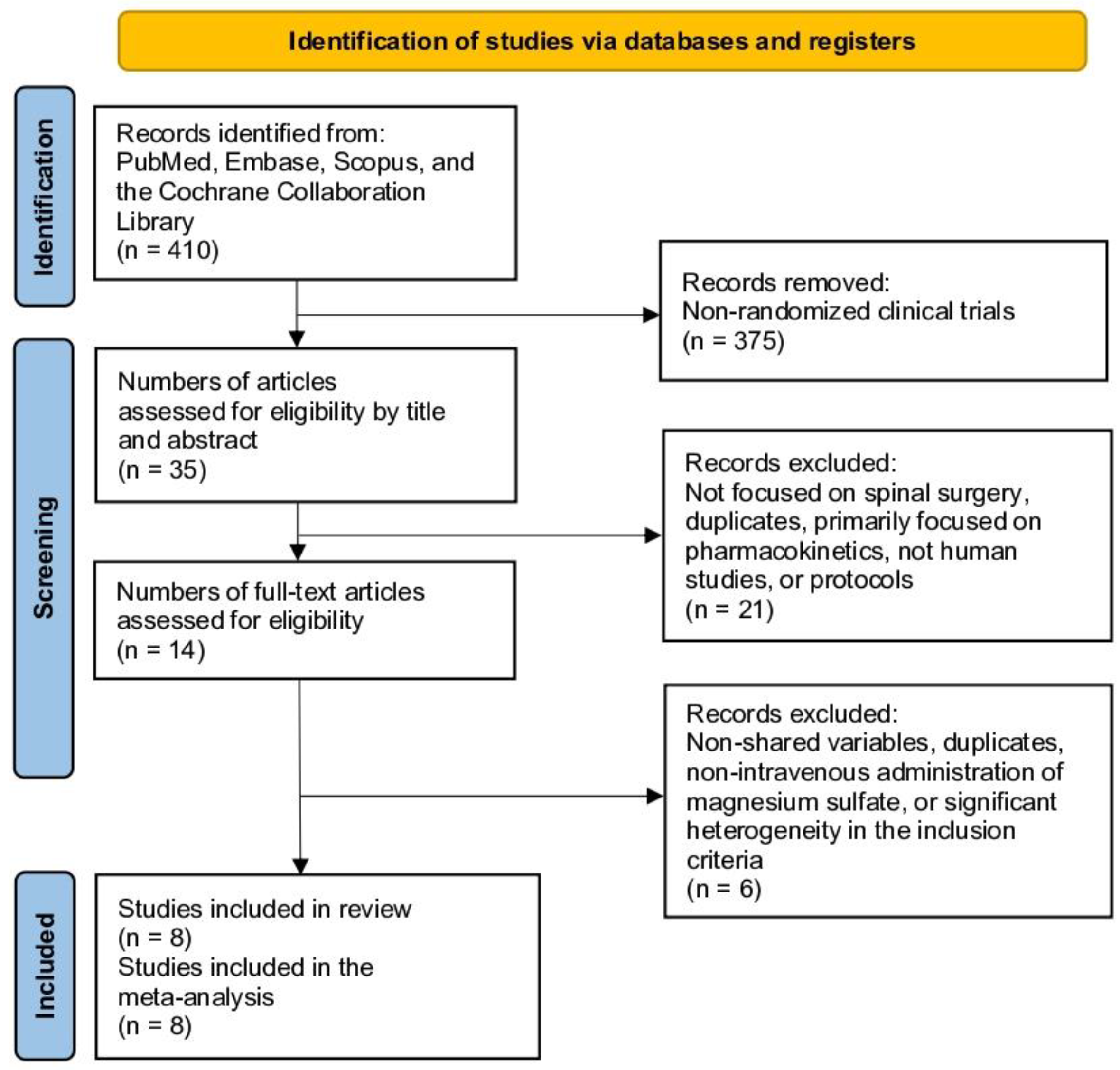
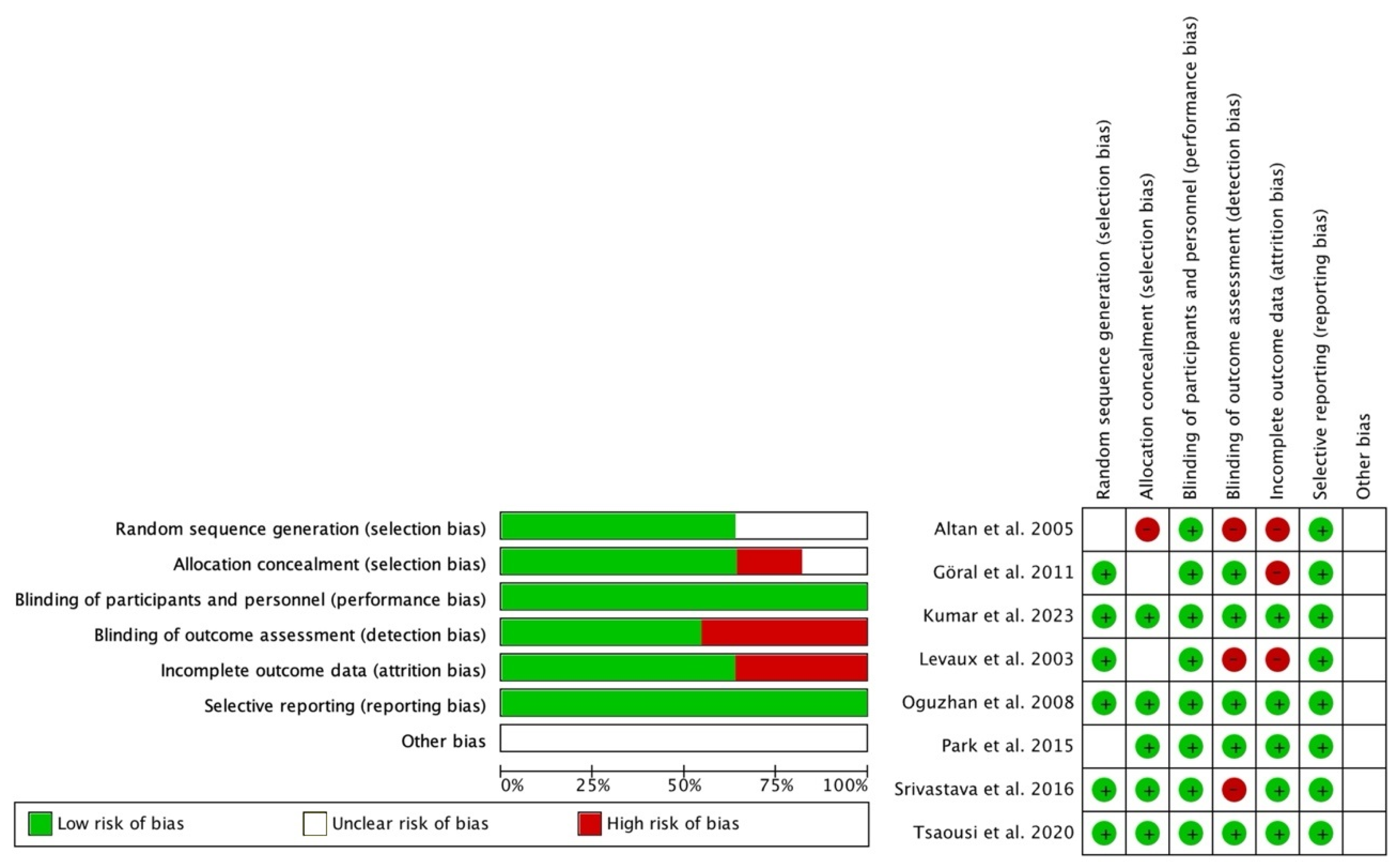
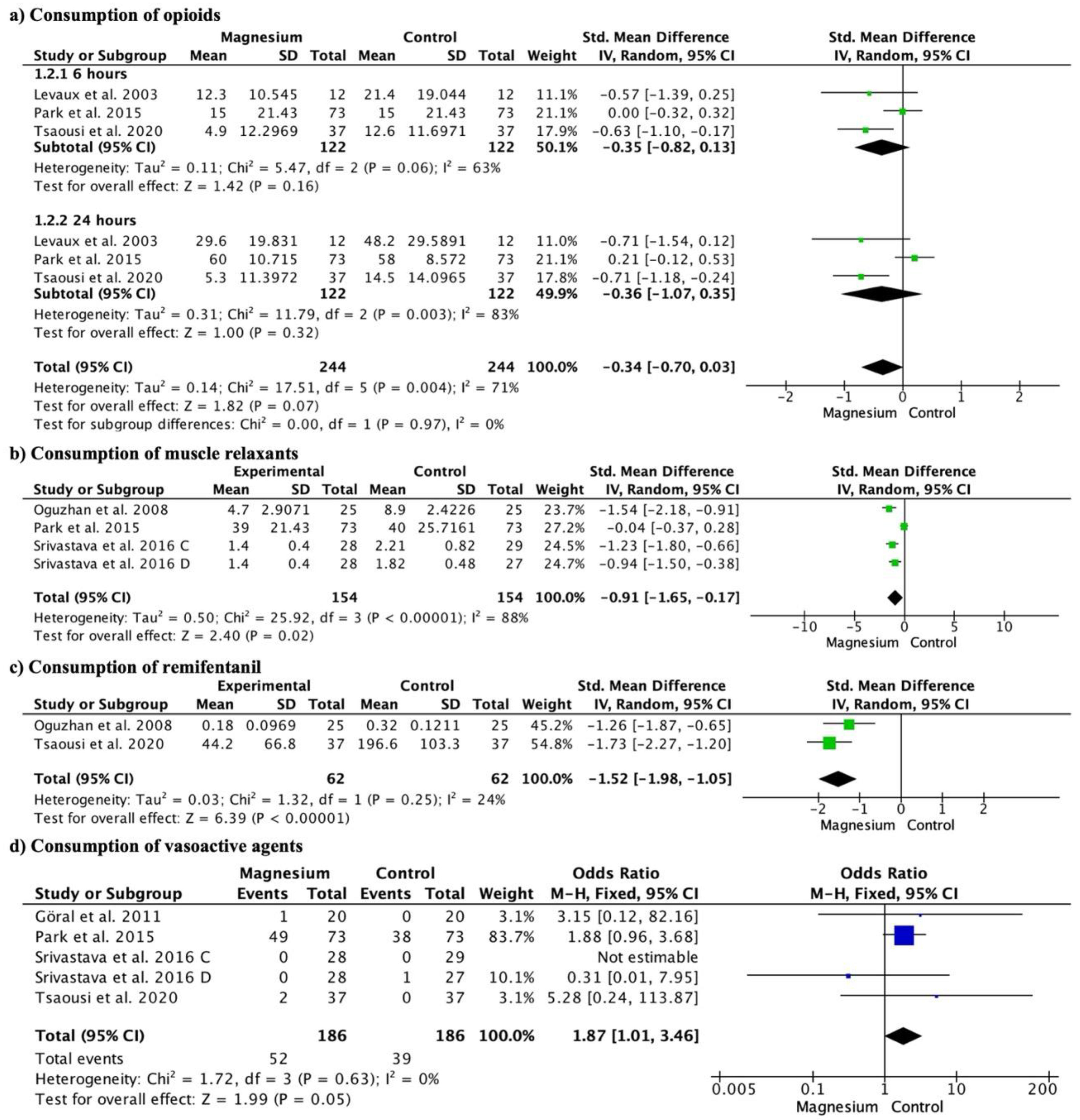
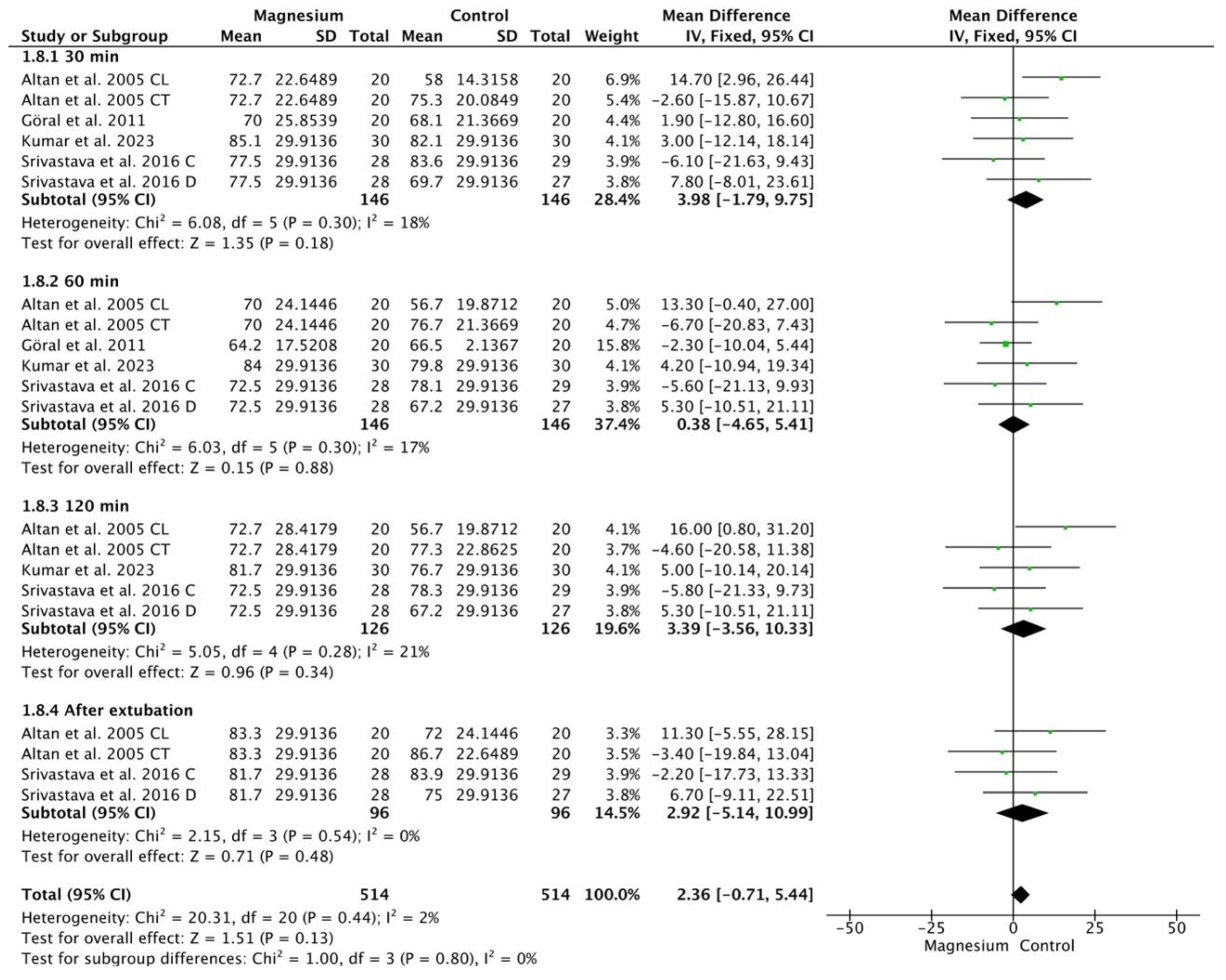
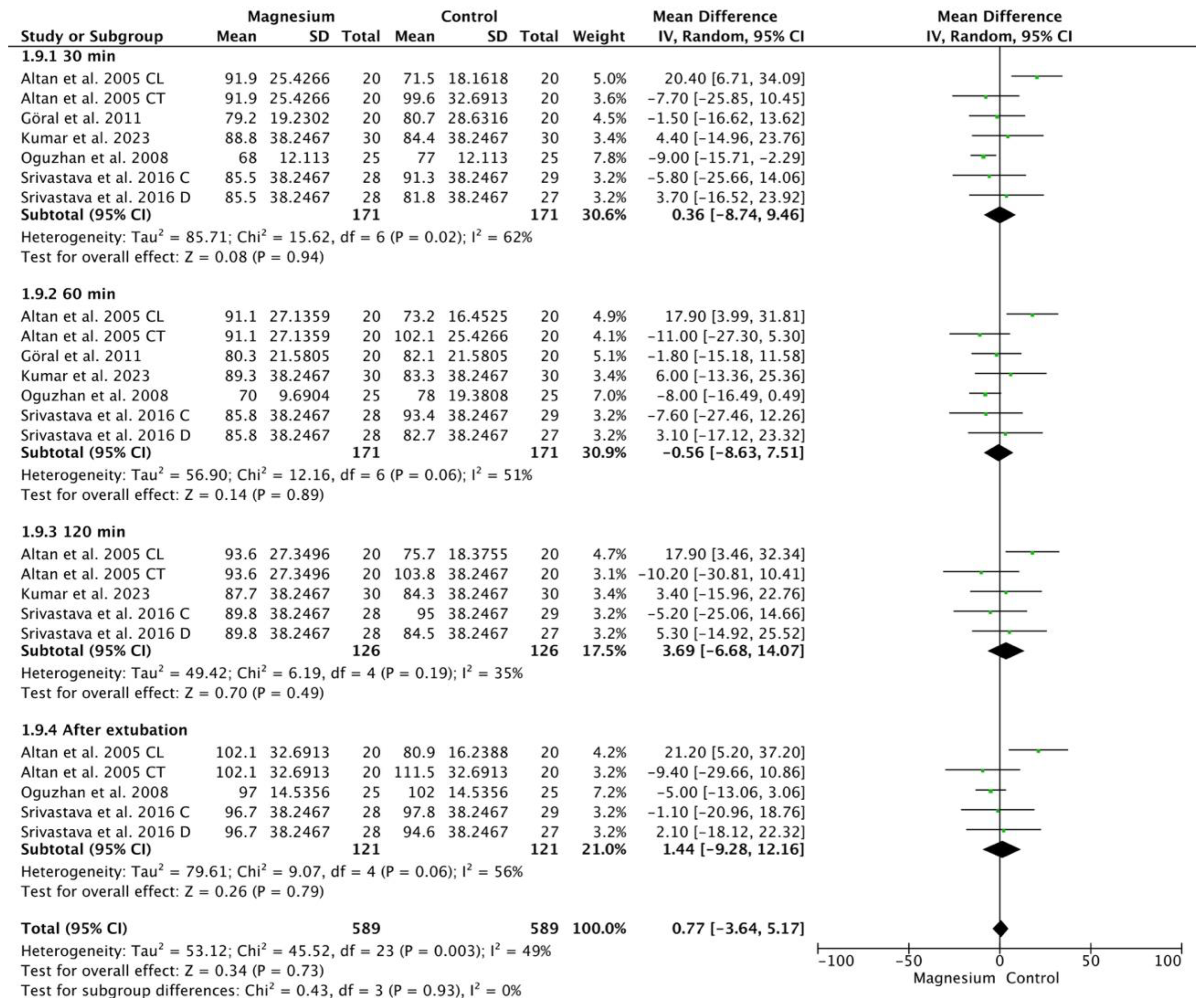
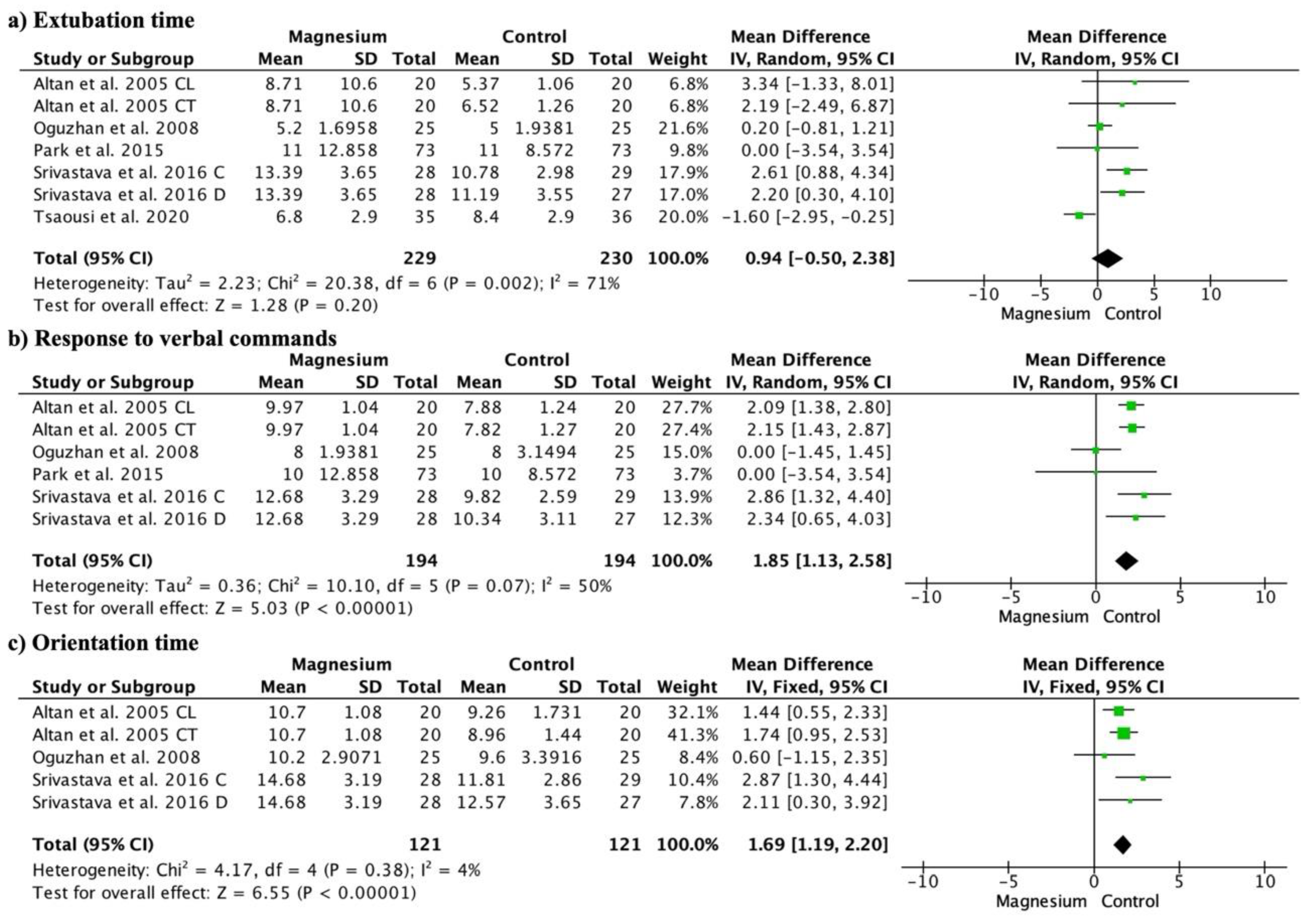
| Study | Region | Period | n MS/CL/Placebo | Age MS/CL/Placebo | n Female MS/CL/Placebo | Etiology | Dose of Magnesium Sulfate |
|---|---|---|---|---|---|---|---|
| Altan et al., 2005 [15] | Turkey | NR | 20/20/20 | 42.3/40.8/44.9 | 7/9/7 | Spine surgery | 30 mg/kg 1 over a 15-min period before induction of anaesthesia and 10 mg/kg 1 h. |
| Göral et al., 2011 [9] | Turkey | NR | 20/NA/20 | 48.0/NA/49.0 | 10/NA/11 | Single-level microscopic lumbar discectomy | 50 mg/kg in 100 mL saline by slow infusion over 10 min, followed by a continuous infusion of 20 mg/kg/h. |
| Kumar et al., 2023 [20] | India | NR | 30/30/NA | 35.2/38.2/NA | 8/5/NA | Single-level lumbar laminectomy | 15 mL of 0.75% ropivacaine + 500 mg equivalent to 1 mL + 4.0 mL normal saline. The total volume of the solution infiltrated was 20 mL in both groups. |
| Levaux et al., 2003 [14] | Belgium | NR | 12/NA/12 | 55.0/NA/46.0 | 8/NA/5 | Lumbar arthrodesis | 50 mg/kg in 250 mL of normal saline over 30 min immediately before induction of anaesthesia. |
| Oguzhan et al., 2008 [10] | Turkey | 2005 to 2006 | 25/NA/25 | 44.0/NA/42.0 | 12/NA/11 | Lumbar disc surgery | 30 mg/kg (over 10 min) starting immediately after induction of anesthesia and completed before intubation; the infusion was then continued at 10 mg/kg/h throughout surgery. |
| Park et al., 2015 [21] | Korea | 2013 to 2014 | 73/73/NA | 51.0/51.0/NA | 32/31/NA | Lumbar spine surgery | 30 mg/kg in a total of 100 mL normal saline was given for 10 min before the induction of anesthesia, followed by continuous infusion of at 10 mg/kg/h until the end of operation. |
| Srivastava et al., 2016 [22] | India | NR | 30/30/30 | 48.3/45.9/46.6 | 13/12/14 | Elective spine surgery | Loading dose 50 mg/kg before induction over a period of 15 min and maintenance 15 mg/kg/h throughout the surgery. |
| Tsaousi et al., 2020 [16] | Greece | 2020 | 35/NA/36 | 55.9/49.0 | 22/NA/21 | Lumbar laminectomy | 20 mg/kg diluted in isotonic saline to a volume of 100 mL was infused as an intravenous (i.v.) bolus dose over 15 min before anesthesia induction and thereafter 20 mg/kg/h was continuously infused until surgery completion. |
| Effect Size | Control Group | n Participants | Fixed Effect Model (OR 95% CI) | I2 (%) |
|---|---|---|---|---|
| Hypotension | Placebo | 138 | OR 2.71, 95% CI 0.74 to 9.95 | 0% |
| Dexmedetomidine | 112 | OR 0.18, 95% CI 0.01 to 3.91 | 0% | |
| Dexamethasone | 146 | OR 2.19, 95% CI 1.10 to 4.36 | 0% | |
| PONV | Placebo | 148 | OR 0.37, 95% CI 0.16 to 0.85 | 0% |
| Dexamethasone | 146 | OR 1.20, 95% CI 0.60 to 2.39 | 0% | |
| Shivering | Placebo | 98 | * OR 0.24, 95% CI 0.01 to 6.80 | 74% |
| Arrythmia | Placebo | NA | NA | NA |
| Dexmedetomidine | 186 | OR 1.62, 95% CI 0.19 to 13.63 | 0% |
| Certainty Assessment | № of Patients | Effect | Certainty | Importance | ||||||||
|---|---|---|---|---|---|---|---|---|---|---|---|---|
| № of Studies | Study Design | Risk of Bias | Inconsistency | Indirectness | Imprecision | Other Considerations | [Intervention] | [Comparison] | Relative (95% CI) | Absolute (95% CI) | ||
| VAS | ||||||||||||
| 5 | randomized trials | not serious | serious a | not serious | Serious b | publication bias strongly suspected c | 531 | 531 | - | MD 0.47 lower (1.64 lower to 0.7 higher) | ⨁◯◯◯ Very low | CRITICAL |
| Opioid consumption | ||||||||||||
| 3 | randomized trials | not serious | not serious | not serious | not serious | publication bias strongly suspected c | 244 | 244 | - | SMD 0.34 lower (0.7 lower to 0.03 higher) | ⨁⨁⨁◯ Moderate | CRITICAL |
| Response to verbal (time) | ||||||||||||
| 6 | randomized trials | not serious | not serious | not serious | not serious | publication bias strongly suspected c | 194 | 194 | - | MD 1.85 higher (1.13 higher to 2.58 higher) | ⨁⨁⨁◯ Moderate | IMPORTANT |
| Muscle relaxants consumption | ||||||||||||
| 4 | randomized trials | not serious | not serious | not serious | not serious | publication bias strongly suspected c | 154 | 154 | - | SMD 0.91 lower (1.65 lower to 0.17 lower) | ⨁⨁⨁◯ Moderate | IMPORTANT |
| HR | ||||||||||||
| 6 | randomized trials | not serious | not serious | not serious | not serious | none | 514 | 514 | - | MD 2.36 higher (0.71 lower to 5.44 higher) | ⨁⨁⨁⨁ High | CRITICAL |
| MAP | ||||||||||||
| 7 | randomized trials | not serious | not serious | not serious | not serious | publication bias strongly suspected c | 589 | 589 | - | MD 0.77 higher (3.64 lower to 5.17 higher) | ⨁⨁⨁◯ Moderate | CRITICAL |
| Hypotension | ||||||||||||
| 6 | randomized trials | not serious | serious a | not serious | not serious | none | 64/198 (32.3%) | 48/198 (24.2%) | OR 1.97 (1.10 to 3.52) | 144 more per 1000 (from 18 more to 287 more) | ⨁⨁⨁◯ Moderate | CRITICAL |
Disclaimer/Publisher’s Note: The statements, opinions and data contained in all publications are solely those of the individual author(s) and contributor(s) and not of MDPI and/or the editor(s). MDPI and/or the editor(s) disclaim responsibility for any injury to people or property resulting from any ideas, methods, instructions or products referred to in the content. |
© 2024 by the authors. Licensee MDPI, Basel, Switzerland. This article is an open access article distributed under the terms and conditions of the Creative Commons Attribution (CC BY) license (https://creativecommons.org/licenses/by/4.0/).
Share and Cite
Campos, J.; Bas, J.L.; Campos, C.; Mariscal, G.; Bas, T.; Bas, P. Efficacy and Safety of Intravenous Magnesium Sulfate in Spinal Surgery: A Systematic Review and Meta-Analysis. J. Clin. Med. 2024, 13, 3122. https://doi.org/10.3390/jcm13113122
Campos J, Bas JL, Campos C, Mariscal G, Bas T, Bas P. Efficacy and Safety of Intravenous Magnesium Sulfate in Spinal Surgery: A Systematic Review and Meta-Analysis. Journal of Clinical Medicine. 2024; 13(11):3122. https://doi.org/10.3390/jcm13113122
Chicago/Turabian StyleCampos, Jorge, Jose Luis Bas, Claudia Campos, Gonzalo Mariscal, Teresa Bas, and Paloma Bas. 2024. "Efficacy and Safety of Intravenous Magnesium Sulfate in Spinal Surgery: A Systematic Review and Meta-Analysis" Journal of Clinical Medicine 13, no. 11: 3122. https://doi.org/10.3390/jcm13113122
APA StyleCampos, J., Bas, J. L., Campos, C., Mariscal, G., Bas, T., & Bas, P. (2024). Efficacy and Safety of Intravenous Magnesium Sulfate in Spinal Surgery: A Systematic Review and Meta-Analysis. Journal of Clinical Medicine, 13(11), 3122. https://doi.org/10.3390/jcm13113122







